+ Open data
Open data
- Basic information
Basic information
| Entry | Database: PDB / ID: 1d9v | ||||||
|---|---|---|---|---|---|---|---|
| Title | HAEMOPHILUS INFLUENZAE FERRIC-BINDING PROTEIN APO FORM | ||||||
 Components Components | PROTEIN (iron-utilization periplasmic protein) | ||||||
 Keywords Keywords | METAL BINDING PROTEIN / FERRIC / BINDING PROTEIN / IRON / APO FORM / PERIPLASMIC PROTEIN / ABC CASSETTE RECEPTOR PROTEIN | ||||||
| Function / homology |  Function and homology information Function and homology informationiron ion transport / transmembrane transport / periplasmic space / metal ion binding Similarity search - Function | ||||||
| Biological species |  Haemophilus influenzae (bacteria) Haemophilus influenzae (bacteria) | ||||||
| Method |  X-RAY DIFFRACTION / Resolution: 1.75 Å X-RAY DIFFRACTION / Resolution: 1.75 Å | ||||||
 Authors Authors | McRee, D.E. / Bruns, C.M. / Williams, P.A. | ||||||
 Citation Citation |  Journal: Biochemistry / Year: 2001 Journal: Biochemistry / Year: 2001Title: Crystallographic and biochemical analyses of the metal-free Haemophilus influenzae Fe3+-binding protein. Authors: Bruns, C.M. / Anderson, D.S. / Vaughan, K.G. / Williams, P.A. / Nowalk, A.J. / McRee, D.E. / Mietzner, T.A. | ||||||
| History |
|
- Structure visualization
Structure visualization
| Structure viewer | Molecule:  Molmil Molmil Jmol/JSmol Jmol/JSmol |
|---|
- Downloads & links
Downloads & links
- Download
Download
| PDBx/mmCIF format |  1d9v.cif.gz 1d9v.cif.gz | 73.9 KB | Display |  PDBx/mmCIF format PDBx/mmCIF format |
|---|---|---|---|---|
| PDB format |  pdb1d9v.ent.gz pdb1d9v.ent.gz | 55.5 KB | Display |  PDB format PDB format |
| PDBx/mmJSON format |  1d9v.json.gz 1d9v.json.gz | Tree view |  PDBx/mmJSON format PDBx/mmJSON format | |
| Others |  Other downloads Other downloads |
-Validation report
| Summary document |  1d9v_validation.pdf.gz 1d9v_validation.pdf.gz | 429.8 KB | Display |  wwPDB validaton report wwPDB validaton report |
|---|---|---|---|---|
| Full document |  1d9v_full_validation.pdf.gz 1d9v_full_validation.pdf.gz | 438.8 KB | Display | |
| Data in XML |  1d9v_validation.xml.gz 1d9v_validation.xml.gz | 15.5 KB | Display | |
| Data in CIF |  1d9v_validation.cif.gz 1d9v_validation.cif.gz | 21.8 KB | Display | |
| Arichive directory |  https://data.pdbj.org/pub/pdb/validation_reports/d9/1d9v https://data.pdbj.org/pub/pdb/validation_reports/d9/1d9v ftp://data.pdbj.org/pub/pdb/validation_reports/d9/1d9v ftp://data.pdbj.org/pub/pdb/validation_reports/d9/1d9v | HTTPS FTP |
-Related structure data
| Related structure data | |
|---|---|
| Similar structure data |
- Links
Links
- Assembly
Assembly
| Deposited unit | 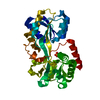
| ||||||||
|---|---|---|---|---|---|---|---|---|---|
| 1 |
| ||||||||
| Unit cell |
|
- Components
Components
| #1: Protein | Mass: 33769.250 Da / Num. of mol.: 1 Source method: isolated from a genetically manipulated source Source: (gene. exp.)  Haemophilus influenzae (bacteria) / Description: GRAM-NEGATIVE HUMAN PATHOGENIC BACTERIA / Gene: HITA / Species (production host): Escherichia coli / Production host: Haemophilus influenzae (bacteria) / Description: GRAM-NEGATIVE HUMAN PATHOGENIC BACTERIA / Gene: HITA / Species (production host): Escherichia coli / Production host:  |
|---|---|
| #2: Chemical | ChemComp-PO4 / |
| #3: Water | ChemComp-HOH / |
-Experimental details
-Experiment
| Experiment | Method:  X-RAY DIFFRACTION / Number of used crystals: 1 X-RAY DIFFRACTION / Number of used crystals: 1 |
|---|
- Sample preparation
Sample preparation
| Crystal | Density Matthews: 2.09 Å3/Da / Density % sol: 41.23 % | ||||||||||||||||||
|---|---|---|---|---|---|---|---|---|---|---|---|---|---|---|---|---|---|---|---|
| Crystal grow | Temperature: 290 K / Method: vapor diffusion, hanging drop / pH: 6.5 Details: PEG 1450, HEPES buffer, pH 6.5, VAPOR DIFFUSION, HANGING DROP, temperature 17K | ||||||||||||||||||
| Crystal grow | *PLUS | ||||||||||||||||||
| Components of the solutions | *PLUS
|
-Data collection
| Diffraction | Mean temperature: 290 K |
|---|---|
| Diffraction source | Source:  ROTATING ANODE / Type: RIGAKU RU200 / Wavelength: 1.5418 ROTATING ANODE / Type: RIGAKU RU200 / Wavelength: 1.5418 |
| Detector | Type: MARRESEARCH / Detector: IMAGE PLATE / Date: Jan 1, 1997 |
| Radiation | Protocol: SINGLE WAVELENGTH / Monochromatic (M) / Laue (L): M / Scattering type: x-ray |
| Radiation wavelength | Wavelength: 1.5418 Å / Relative weight: 1 |
| Reflection | Resolution: 1.75→100 Å / Num. all: 27731 / Num. obs: 27731 / % possible obs: 94.2 % / Observed criterion σ(F): 0 / Observed criterion σ(I): 0 / Rmerge(I) obs: 0.059 |
| Reflection shell | Resolution: 1.75→1.86 Å / Rmerge(I) obs: 0.37 / Num. unique all: 3703 / % possible all: 77 |
| Reflection | *PLUS Lowest resolution: 8 Å / Num. obs: 27754 / Redundancy: 6.7 % |
| Reflection shell | *PLUS % possible obs: 77 % / Redundancy: 3.5 % / Num. unique obs: 3703 |
- Processing
Processing
| Software |
| |||||||||||||||
|---|---|---|---|---|---|---|---|---|---|---|---|---|---|---|---|---|
| Refinement | Resolution: 1.75→100 Å / σ(F): 0 / σ(I): 0
| |||||||||||||||
| Refinement step | Cycle: LAST / Resolution: 1.75→100 Å
| |||||||||||||||
| Refine LS restraints |
| |||||||||||||||
| Software | *PLUS Name: TNT / Classification: refinement | |||||||||||||||
| Refinement | *PLUS Lowest resolution: 8 Å / Rfactor obs: 0.179 | |||||||||||||||
| Solvent computation | *PLUS | |||||||||||||||
| Displacement parameters | *PLUS | |||||||||||||||
| Refine LS restraints | *PLUS Type: t_angle_deg / Dev ideal: 2.22 | |||||||||||||||
| LS refinement shell | *PLUS Highest resolution: 1.75 Å / Lowest resolution: 1.86 Å / Rfactor Rfree: 0.38 / Rfactor obs: 0.37 |
 Movie
Movie Controller
Controller



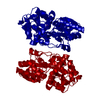
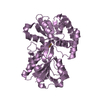
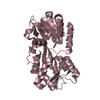
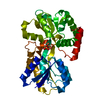
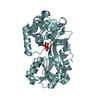



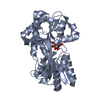
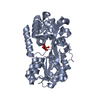
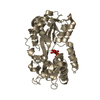

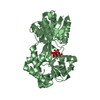

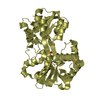
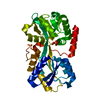
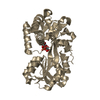
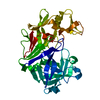
 PDBj
PDBj





